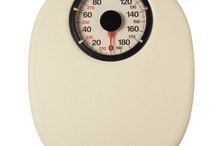How to Lose About 20 Pounds in 5-6 Months & Keep it Off
According to the Mayo Clinic and other organizations, losing 1 to 2 pounds per week is a realistic and safe weight-loss goal. So aiming to lose 20 pounds in five or six months through a calorie deficit of -- on average -- 3500 calories per week is a safe target and probably doable. However, for various reasons, both physical and psychological, keeping that weight off could be more of a challenge.
Losing Weight
Cut calorie intake. Excess calories are stored as fat. To lose weight, you need to use up those excess calories. Losing 1 pound per week requires a calorie deficit of about 500 calories per day. When deciding where to cut calories, be careful not to cut back on important nutrients. You should plan on eating from the major food groups -- fruits, grains, proteins, vegetables and dairy -- each day. Portions will vary depending on your gender, age and size.
How to Lose About 20 Pounds in 5-6 Months & Keep it Off
Learn More
Increase your activity level. Since a minimum number of calories are required to remain healthy and get the necessary nutrients in your diet, cutting calories alone is not a good idea. You should aim to achieve your calorie deficit through a combination of diet and exercise. The American College of Sports Medicine notes that losing weight generally requires doing more than 250 minutes of moderate activity per week. The Mayo Clinic says that as much as 300 minutes per week may be required. Moderate activity includes walking, biking and swimming but also includes housework, such as vacuuming and gardening.
Reduce dietary fat. One gram of fat contains nine calories, as opposed to proteins and carbohydrates, which have four calories per gram. Cutting fat will make it easier to achieve your caloric deficit. The American Heart Association recommends limiting overall fat intake to 25 to 35 percent of daily calories. To lose weight, stay toward the low end of that and try to limit those fats to polyunsaturated fats from vegetable oils, nuts, seeds and fish.
Three Components of a Weight Loss Program
Learn More
Prepare for the weight-loss plateau. The Mayo Clinic warns that after the first few weeks of diet and increased exercise, it is common for the body to adjust to the calorie deficit and for the metabolism to slow. At this point, drop another 200 daily calories, if you can do that safely while still getting the minimum caloric requirement for your size, age and gender; increase your activity, even by small amounts, like walking around your house for 10 or 15 additional minutes per day and consider engaging in strength training. While strength training will have a small, if any, effect on pounds lost, it will lead to an increased percentage of lean mass in your body, which is much healthier in the long run.
Keep Weight Off
Think lifestyle change. According to the ACSM, maintaining weight loss requires 150 to 250 minutes of moderate activity per day. That is less than required to lose weight, but it still means you will want to find an activity you like and can continue for the long term. It's also a good idea to find alternative activities, for example, swimming rather than walking in extremely hot weather.
Find ways to maintain a healthy diet. As with exercise, you won't stick with something you hate. If you like to snack, keep healthy snacks around the house, such as seeds and nuts or cut-up carrots. Avoid satisfying your sweet cravings with empty sugary foods and choose fruits and berries instead. Try to eliminate trans fats from your diet entirely.
Build treats into your diet. In "Fitness," Kathy McManus, RD, notes that "being super-strict" could lead to failure. You can't go your entire life without ice cream and cake or the things you crave, like chocolate. One strategy is to allow yourself one "cheat day" a week to indulge in whatever you want; another is to indulge cravings when they arise but control the size of portions. Yet another is to build those calories into your diet without letting them squeeze out necessary nutritious calories.You may need to experiment to find what works best for you.
Tips
If "exercise" doesn't appeal to you, think in terms of "activity," which includes dancing, mowing the lawn with a push mower or simply walking up and down stairs.
Your percentage of fat to lean mass or your waist-to-hip ratio can be a better indicator of a healthy body than just how much you weigh. Consider having a trained professional make these measurements for you.
Warnings
Check with your physician before beginning a diet and exercise program to determine if you really do need to lose weight and how much.
Don't engage in fad dieting that requires eliminating certain food groups from your diet entirely. Even fat is necessary for good health.
Related Articles
References
- Mayo Clinic.com: Counting calories: Get back to weight-loss basics
- Weight loss: 6 strategies for success
- ACSM: Position Stand on Physical Activity and Weight Loss
- Mayo Clinic.com: Exercise for weight loss: Calories burned in 1 hour
- Calorie counts fat, protein carbohydrate
- Mayo Clinic.com: Getting past a weight-loss plateau
- Fitness: Your Toughest Diet Dilemmas Solved: Can I Cheat?
Resources
Writer Bio
This article was written by the CareerTrend team, copy edited and fact checked through a multi-point auditing system, in efforts to ensure our readers only receive the best information. To submit your questions or ideas, or to simply learn more about CareerTrend, contact us [here](http://careertrend.com/about-us).








